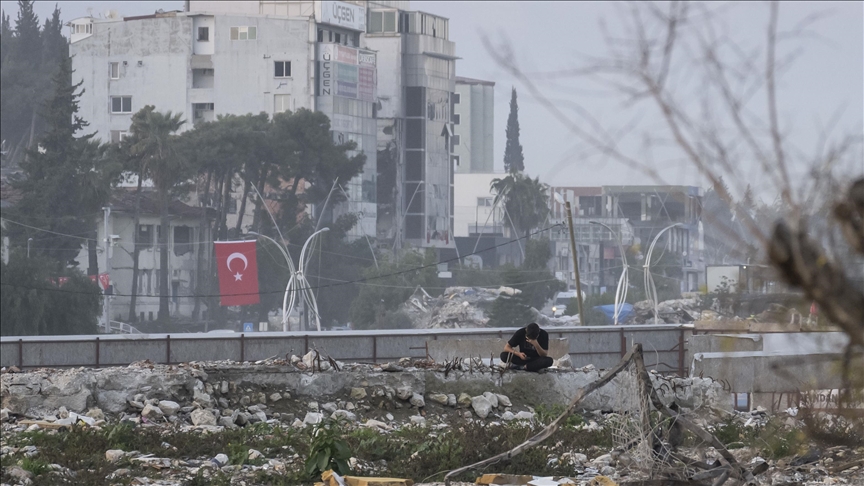Türkiye is marking the first anniversary of the deadly magnitude 7.7 and 7.6 earthquakes that hit just nine hours apart on Feb. 6, 2023.
Centered in the Pazarcık district of southern Kahramanmaraş, the first tremor struck at 4.17 a.m. local time (1:17 a.m. GMT) at a depth of 7 kilometers (4.3 miles).
Described as the “disaster of the century” that directly affected 14 million citizens, killed 53,537 and injured 107,213, Türkiye declared a Level 4 alert, including international aid, and national mourning was declared throughout the country for seven days.
More than 14 million people in Türkiye were affected by the quakes, as well as many others in northern Syria.
Honouring the memory of those who perished
People across the country, including the earthquake-hit provinces, assembled for commemoration ceremonies, honouring the memory of those who perished in the disaster.
A moment of silence and homage was held to remember the victims of the ‘Disaster of the Century’ at 4.17 a.m. local time (0117GMT), the moment the tremor struck.
In Antakya people threw flowers in the Orontes river that flows through the city and heard a local orchestra play “In the Wake of Those Who Have Left,” a composition created to remember the victims.
The aftermath
Thousands of homes were reduced to rubble, with the cities still having gaping holes in place of residences that toppled like houses of cards when the ground began to move with the first tremor.
In the aftermath, a frenetic race against time ensued as rescue teams, both domestic and international, endeavored to extricate survivors ensnared beneath the rubble. Reports of survivors emerging from the wreckage continued to surface, often hours or even days after the initial tremor. During an almost month-long search and rescue efforts, the entire nation also rallied to provide assistance, addressing the urgent need for shelter and sustenance in the harsh winter conditions.
Countless trucks departed from various aid hubs in cities, distributing meticulously assembled packages containing clothing, blankets, heaters and personal hygiene items to those affected.
Survivors struggle to rebuild their lives
As the disaster enters its second year, the most significant challenge for millions whose homes were demolished is still housing.
With tent cities that initially dominated the landscape largely yielding to containers, the quake survivors still grapple with persisting challenges, particularly in terms of heating and sanitation.
Concurrently, the arduous task of demolishing severely damaged structures and clearing debris persists in the 11 southern provinces, paralleled by sustained efforts in the realm of permanent housing constructions.
In Hatay, an epicenter of extensive structural damage, with an estimated one in two buildings either collapsing or sustaining severe destruction, the city strives to erase the scars of the disaster. The removal of debris from iconic structures has engendered voids within the urban fabric, inducing a disorienting sense for even Hatay residents who elected to remain, akin to navigating an unfamiliar city due to the absence of familiar landmarks.

A significant portion of earthquake survivors in Hatay reside in established container cities, where nylon covers are used to prevent leaks from rain and snow. Predominant among the persisting concerns are challenges related to heating within these containers.
A Turkish family is still afraid to go home one year after deadly earthquake
Fatma Kirici lives in a tent with her husband and two grown children, afraid to return to the multistory house they fled that somehow still stands.
“Our house is at the edge of a precipice,” said Kirici, 50, whose 20-year-old daughter and son-in-law died in the quake when their house collapsed. “I don’t want to put my other kids at risk.”

Because Kirici’s house was only “slightly damaged,” according to the government, the family does not qualify for either the subsidized housing under construction or a container home.
So they are spending another winter exposed to the elements: Cold rain regularly soaks the ground under their tent and the mattresses where they sleep, and every so often an aftershock rattles southern Turkey and the family’s nerves.
Read the full story here: https://www.independent.co.uk/news/ap-turkish-recep-tayyip-erdogan-red-cross-unemployment-b2488537.html
Further reading: https://www.reuters.com/pictures/pictures-life-after-turkeys-earthquake-one-year-2024-02-05/
The situation in Syria has only become more grim for those who survived
In Syria, the United Nations said 6,000 people lost their lives, the majority in Idlib. Other estimates put the number higher. The earthquake followed more than a decade of civil war that had severely damaged Syria’s infrastructure. Some of the worst quake-hit areas were also those most devastated by the conflict, including the city of Aleppo.
In the weeks after the earthquake, humanitarian aid started flowing into Syria and a U.N. appeal raised nearly $387 million in pledges.
But months later, as other crises emerged, priorities for Syria appeared to fall by the wayside. To this day, humanitarian agencies are struggling to draw the world’s attention back to the war-ravaged country as they face donor fatigue and shrinking budgets.

In many places, rubble remains where it fell as people struggle to survive in tents and prefabricated containers a year after the quake. Some 4 million people rely on humanitarian assistance amid a surge in violence in northern Syria.
Sources: Daily Sabah/Associated Press/TRT World/abc NEWS/The Independent






